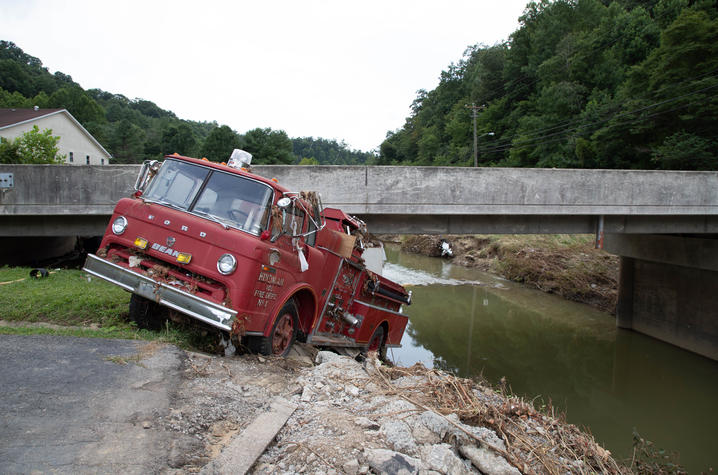Flooding aftermath: cleanup best practices to keep everyone healthy and safe

The University of Kentucky Public Relations and Strategic Communications Office provides a weekly health column available for use and reprint by news media. This week's column is by Erin Haynes, Dr.P.H., chair of the Department of Epidemiology and Environmental Health in the University of Kentucky College of Public Health.
LEXINGTON, Ky. (Aug. 8, 2022) — As the flood waters begin to recede, families, business owners and volunteer cleanup groups will begin to reenter the damaged buildings and start the long cleanup process. Unfortunately, many flood-related injuries and health issues, even death, can occur during the cleanup response. It is critical to remember that although the flood waters may recede, there are a number of hazards to be aware of.
If you or someone you know is planning to respond to the flooding disaster by cleaning up debris, please protect yourself and others around you. Be mindful of the following:
- Before entering a home or building, ensure that the building is stable. Assume that all stairs, floors and roofs are unsafe until inspected.
- Do not do any demolition yourself. Demolition should only be done by a highly skilled, trained worker.
- Be on the lookout and stay away from damaged power and utility lines. Call 911 if you suspect damaged utilities, and do not enter the area. If water is covering or even near an electric outlet, the water could be carrying a charge resulting in electric shock, burns or electrocution.
- Portable generators emit carbon monoxide (CO). CO is odorless and colorless. Breathing CO can result in headache, dizziness, drowsiness or nausea, leading to loss of consciousness. Prolonged exposure can lead to coma or death. Only use generators outdoors in a dry location at least 20 feet away from doors and windows and never in attached garages.
- During debris removal, wear safety shoes with slip-resistant soles, safety glasses, leather work gloves, a hard hat, long pants and a long sleeve shirt.
- Assume that homes built before 1979 contain asbestos. Asbestos fibers can become airborne and inhaled during cleanup. Because of the known hazards of asbestos, cleanup should only be done by a licensed professional wearing appropriate personal protective equipment (PPE).
- Assume that homes built before 1978 contain lead. Lead is highly toxic to humans, especially children and pregnant women.
- Mold will be a major issue in areas affected by the flood. Mold grows on almost anything and can spread quickly! It can cause allergic reactions, eye and skin irritation and an increase in asthma symptoms. If handling materials with mold, wear an N95 respirator, goggles, protective gloves and coveralls.
- During the cleanup, be aware of your surroundings and how your body is responding to the exertion. Cleanup work can cause heat stress, heat exhaustion and heat stroke. Be sure to take frequent breaks and drink plenty of water. Be aware of those working around you, and check in on them often.
Numerous resources and information are available to help you protect yourself and others during the flood response. Our UK Department of Epidemiology and Environmental Health in the College of Public Health has created a list of resources to protect the health and safety of all cleanup crews and individuals. If you or others you know will be engaging in cleanup, please visit this website to learn about more precautions.
The flood already has taken far too many lives. Let’s watch out for each other to ensure that it doesn’t take more.
As the state’s flagship, land-grant institution, the University of Kentucky exists to advance the Commonwealth. We do that by preparing the next generation of leaders — placing students at the heart of everything we do — and transforming the lives of Kentuckians through education, research and creative work, service and health care. We pride ourselves on being a catalyst for breakthroughs and a force for healing, a place where ingenuity unfolds. It's all made possible by our people — visionaries, disruptors and pioneers — who make up 200 academic programs, a $476.5 million research and development enterprise and a world-class medical center, all on one campus.




